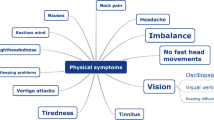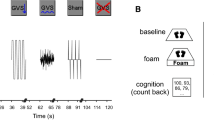Abstract
There are tight functional and anatomical links between the vestibular and interoceptive systems, and both systems have shown to fundamentally underlie emotional processes and our sense of a bodily self. Yet, nothing is known about how long-term bilateral vestibulopathy (BVP) influences interoception and its relation to embodiment and the sense of self. We thus compared cardiac interoceptive accuracy, confidence in the performance, and general body awareness in 25 BVP patients and healthy controls using a heartbeat tracking task, self-reports about interoceptive awareness, as well as measures of self-localization and of self–body closeness. Results showed no difference between patients and controls regarding interoceptive accuracy, confidence and body awareness, suggesting that long-term BVP does not influence cardiac interoception. Patients and controls did not differ either regarding self-location and self–body closeness. However, in our overall sample of patients and controls, we found that interoceptive accuracy increased with perceived self–body closeness, suggesting that anchoring the self to the body is generally linked with better cardiac interoception. This result is in line with previous suggestions of an important contribution of interoception to the sense of embodiment.




Similar content being viewed by others
References
Smith PF (2017) The vestibular system and cognition. Curr Opin Neurol 30:84–89. https://doi.org/10.1097/WCO.0000000000000403
Lopez C (2016) The vestibular system: balancing more than just the body. Curr Opin Neurol 29:74–83. https://doi.org/10.1097/WCO.0000000000000286
Jauregui-Renaud K (2015) Vestibular function and depersonalization/derealization symptoms. Multisens Res 28:637–651
Jacob RG, Furman JM (2001) Psychiatric consequences of vestibular dysfunction. Curr Opin Neurol 14:41–46
Lucieer F, Duijn S, Van Rompaey V et al (2018) Full spectrum of reported symptoms of bilateral vestibulopathy needs further investigation—a systematic review. Front Neurol. https://doi.org/10.3389/fneur.2018.00352
Craig AD (2003) Interoception: the sense of the physiological condition of the body. Curr Opin Neurobiol 13:500–505
Khalsa SS, Adolphs R, Cameron OG et al (2018) Interoception and Mental Health: a roadmap. Biol Psychiatry CognNeurosci Neuroimaging 3:501–513. https://doi.org/10.1016/j.bpsc.2017.12.004
Blanke O (2012) Multisensory brain mechanisms of bodily self-consciousness. Nat Rev Neurosci 13:556–571. https://doi.org/10.1038/nrn3292
Azzalini D, Rebollo I, Tallon-Baudry C (2019) Visceral signals shape brain dynamics and cognition. Trends Cogn Sci 23:488–509. https://doi.org/10.1016/j.tics.2019.03.007
Park H-D, Blanke O (2019) Coupling inner and outer body for self-consciousness. Trends Cogn Sci 23:377–388. https://doi.org/10.1016/j.tics.2019.02.002
Craig AD (2009) How do youfeel-now? The anterior insula and humanawareness. Nat Rev Neurosci 10:59–70. https://doi.org/10.1038/nrn2555
Dutov AM (1974) Responses of neurons of the vestibular nuclei to interoceptive stimulation. Bull Exp Biol Med 78:849–851
Balaban CD, Porter JD (1998) Neuroanatomic substrates for vestibulo-autonomic interactions. J Vestib Res 8:7–16
Jauregui-Renaud K, Gresty MA, Reynolds R, Bronstein AM (2001) Respiratory responses of normal and vestibular defective human subjects to rotation in the yaw and pitch planes. Neurosci Lett 298:17–20. https://doi.org/10.1016/S0304-3940(00)01731-6
Schandry R (1981) Heart beat perception and emotional experience. Psychophysiology 18:483–488
Garfinkel SN, Seth AK, Barrett AB et al (2015) Knowing your own heart: distinguishing interoceptive accuracy from interoceptive awareness. Biol Psychol 104:65–74. https://doi.org/10.1016/j.biopsycho.2014.11.004
Frasnelli J, Collignon O, Voss P, Lepore F (2011) Crossmodal plasticity in sensory loss. Prog Brain Res 191:233–249. https://doi.org/10.1016/B978-0-444-53752-2.00002-3
Beaulieu-Lefebvre M, Schneider FC, Kupers R, Ptito M (2011) Odor perception and odor awareness in congenital blindness. Brain Res Bull 84:206–209. https://doi.org/10.1016/j.brainresbull.2010.12.014
Mittelstaedt H (1992) Somatic versus vestibular gravity reception in man. Ann N Y Acad Sci 656:124–139
Krajnik J, Kollndorfer K, Notter LA et al (2015) The impact of olfactory dysfunction on interoceptive awareness. Psychophysiology 52:263–268. https://doi.org/10.1111/psyp.12316
Montoya P, Schandry R (1994) Emotional experience and heartbeat perception in patients with spinal cord injury and control subjects. J Psychophysiol 8:289–296
Cabrera A, Kolacz J, Pailhez G et al (2018) Assessing body awareness and autonomic reactivity: factor structure and psychometric properties of the Body Perception Questionnaire-Short Form (BPQ-SF). Int J Methods Psychiatr Res 27:e1596. https://doi.org/10.1002/mpr.1596
Critchley HD, Wiens S, Rotshtein P et al (2004) Neural systems supporting interoceptive awareness. Nat Neurosci 7:189–195
Starmans C, Bloom P (2012) Windows to the soul: Children and adults see the eyes as the location of the self. Cognition 123:313–318. https://doi.org/10.1016/j.cognition.2012.02.002
Limanowski J, Hecht H (2011) Where do we stand on locating the self? Psychology 02:312–317. https://doi.org/10.4236/psych.2011.24049
Fetterman AK, Robinson MD (2013) Do you use your head or follow your heart? Self-location predicts personality, emotion, decision making, and performance. J Pers Soc Psychol 105:316–334. https://doi.org/10.1037/a0033374
Porciello G, Daum MM, Menghini C et al (2016) Not that heart-stopping after all: visuo-cardiac synchrony does not boost self-face attribution. PLoS ONE 11:e0160498. https://doi.org/10.1371/journal.pone.0160498
Deroualle D, Toupet M, van Nechel C et al (2017) Anchoring the self to the body in bilateral vestibular failure. PLoS ONE 12:e0170488. https://doi.org/10.1371/journal.pone.0170488
Strupp M, Arbusow V, Dieterich M et al (1998) Perceptual and oculomotor effects of neck muscle vibration in vestibular neuritis. Ipsilateral somatosensory substitution of vestibular function. Brain 121:677–685
Zigmond AS, Snaith RP (1983) The hospital anxiety and depression scale. Acta Psychiatr Scand 67:361–370
Peirce JW (2007) PsychoPy—psychophysics software in python. J Neurosci Methods 162:8–13
Aron A, Aron EN, Smollan D (1992) Inclusion of other in the self scale and the structure of interpersonal closeness. J Pers Soc Psychol 63:596–612. https://doi.org/10.1037/0022-3514.63.4.596
Ring C, Brener J (2018) Heartbeat counting is unrelated to heartbeat detection: a comparison of methods to quantify interoception. Psychophysiology 55:e13084. https://doi.org/10.1111/psyp.13084
Jauregui-Renaud K, Yarrow K, Oliver R et al (2000) Effects of caloric stimulation on respiratory frequency and heart rate and blood pressure variability. Brain Res Bull 53:17–23. https://doi.org/10.1016/s0361-9230(00)00304-x
Garfinkel SN, Manassei MF, Hamilton-Fletcher G et al (2016) Interoceptive dimensions across cardiac and respiratory axes. Philos Trans R Soc Lond, B, Biol Sci. https://doi.org/10.1098/rstb.2016.0014
Trousselard M, Barraud P, Nougier V et al (2004) Contribution of tactile and interoceptive cues to the perception of the direction of gravity. Brain Res Cogn Brain Res 20:355–362. https://doi.org/10.1016/j.cogbrainres.2004.03.008
Lopez C, Nakul E, Preuss N et al (2018) Distorted own-body representations in patients with dizziness and during caloric vestibular stimulation. J Neurol 265:86–94. https://doi.org/10.1007/s00415-018-8906-8
Lopez C, Elzière M (2018) Out-of-body experience in vestibular disorders—a prospective study of 210 patients with dizziness. Cortex 104:193–206. https://doi.org/10.1016/j.cortex.2017.05.026
Ferrè ER, Lopez C, Haggard P (2014) Anchoring the self to the body: vestibular contribution to the sense of self. Psychol Sci 25:2106–2108. https://doi.org/10.1177/0956797614547917
Deroualle D, Borel L, Devèze A, Lopez C (2015) Changing perspective: the role of vestibularsignals. Neuropsychologia 79(Part B):175–185. https://doi.org/10.1016/j.neuropsychologia.2015.08.022
Candidi M, Micarelli A, Viziano A et al (2013) Impaired mental rotation in benign paroxysmal positional vertigo and acute vestibular neuritis. Front Hum Neurosci 7:783. https://doi.org/10.3389/fnhum.2013.00783
Claparède E (1925) Note sur la localisation du moi. Arch Psychol 19:172–182
Tsakiris M, Tajadura-Jiménez A, Costantini M (2011) Just a heartbeat away from one’s body: interoceptive sensitivity predicts malleability of body-representations. Proc Biol Sci 278:2470–2476. https://doi.org/10.1098/rspb.2010.2547
Tschan R, Wiltink J, Adler J et al (2013) Depersonalization experiences are strongly associated with dizziness and vertigo symptoms leading to increased health care consumption in the German general population. J NervMent Dis 201:629–635. https://doi.org/10.1097/NMD.0b013e3182982995
Kolev OI, Georgieva-Zhostova SO, Berthoz A (2014) Anxiety changes depersonalization and derealization symptoms in vestibular patients. Behav Neurol 2014:847054. https://doi.org/10.1155/2014/847054
Noel J-P, Pfeiffer C, Blanke O, Serino A (2015) Peripersonal space as the space of the bodily self. Cognition 144:49–57. https://doi.org/10.1016/j.cognition.2015.07.012
Nakul E, Orlando-Dessaints N, Lenggenhager B, Lopez C (2020) Measuring perceived self-location in virtual reality. Sci Rep 10:6802. https://doi.org/10.1038/s41598-020-63643-y
Acknowledgements
The authors declare no competing financial interests. The research leading to these results has received funding from the Swiss National Science Foundation (Grant number: PP00P1_170511).
Author information
Authors and Affiliations
Corresponding author
Ethics declarations
Conflicts of interest
None.
Ethical approval
Procedures were approved by the Ethics Committee and followed the Declaration of Helsinki.
Informed consent
All participants were informed about the study and gave written informed consent.
Rights and permissions
About this article
Cite this article
Nakul, E., Dabard, C., Toupet, M. et al. Interoception and embodiment in patients with bilateral vestibulopathy. J Neurol 267 (Suppl 1), 109–117 (2020). https://doi.org/10.1007/s00415-020-10221-x
Received:
Revised:
Accepted:
Published:
Issue Date:
DOI: https://doi.org/10.1007/s00415-020-10221-x




